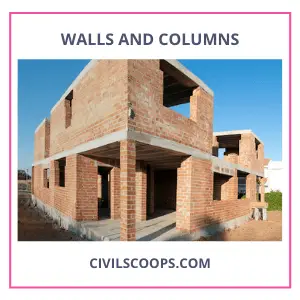How a Building Is Constructed | Components of Building
 How a Building Is Constructed
How a Building Is Constructed
In the building construction process, there have two main part that’s are below-
1. Pre-Construction Steps
In building construction, the pre-construction steps are more important and first taking steps.
- Acquire Land
- Consultant Seek / Technical.
- Design Process.
- Prepare Estimation and Budgets.
- Building Permits.
- Approach a Contractor.
- Building Warranty Period.
1.1 Acquire land
- Acquire land is the most important step in building construction.
- In this process, we have to find a location for the building construction.
1.2 Consultant Seek / Technical
- Constantan professional architect to create building designs, after selecting proper land for building.
- After that as pre-requirement and depends on budget, an architect prepare plan according to the building.
1.3 Design process
- We have to make a rough requirement list for our home, before meeting up with an architect.
- To make the design you can take help from your family as ask their requirements.
1.4 Prepare Estimation and Budgets
- A huge amount of budget and quantity of material is needed for Building construction.
- To prepare an abstract sheet of the cost of building construction the building estimator estimate the material quantity and budget.
1.5 Building Permits
- after the project is ready to be executed the is important work is building permits.
- before we can go for the construction like airport authority, municipal, pollution control, etc. we must take permission from different boards.
- Some essential documents for every building construction work-
- Land Survey
- All drawings like Elevation, Plan, Section, etc.
- Structural Certificate.
- Soil test report.
- Architect Certificate.
1.6 Approach a Contractor
- For timely construction of work and securing building construction quality for construction, a contractor is chosen carefully.
- Before handing work has to be done Pre investigation about the builder.
2. During Building Construction Steps
There have some important steps that are are below-
- Site Clearance.
- Plinth Beam or Slab.
- Superstructure Column and Beam.
- Brick Masonry Work.
- Lintel Over Door Window.
- Floor Slab or Roof Structure.
- Door and Window Framing and Fixations.
- Electrical and Plumbing.
- Exterior Finishing.
- Internal Finishes.
- Woodwork and Fixture Fittings.
- Boundary Wall and Gates.
- Hardscaping and Landscaping.
2.1 Site Clearance
- It becomes necessary to clear the place from the unwanted boulder, grass, etc.
2.2 Excavation
- The excavation is required to forward the work and obtain a level surface.
2.3 Foundation
- The part which is constructed above the sub-soil and for carrying the load coming from the superstructure is called the foundation.
- The foundation provides a level for the superstructure, above which the superstructure is constructed.
- The foundation provides stability to the structure.
- The foundation prevents the overturning of the structure from the lateral pressure.
2.4 Plinth Beam or Slab

- The foundation is on piles the plinth is constructed to support the superstructure.
- A 75mm thick damp-proof course of plane cement concrete is providing on the top of the plinth.
2.5 Superstructure Column and Beam
- The columns and walls are constructed in the structure to transfer the load vertically downward, the loads from the floors or roof are transferred to the foundation.
- The main function of the walls is, they provide privacy and divided the building into many parts.
- The walls provide safety from insects and burglars.
- The walls keep the building cool in summer and warm in winter.
2.6 Brick Masonry Work
- In brick masonry number of terms are used that’s are below-
- Stretcher course.
- Header course.
- Bed course.
- Bed joint.
- Arises course.
- Lap course.
- Perpends course.
- Quoin course.
- Bat course.
- Queen closer.
- King closer.
2.7 Lintel Over Door Window

- To support from the structure above the building, the lintel is a beam that is placed across the openings like windows, doors, etc.
- To the width of the wall, the width of the lintel beam is equal, and the lintel beam is end to the end of the walls.
- Based on their material of construction the lintels are classified.
- as compared to arches the horizontal lintels are easy to construct.
2.8 Floor Slab or Roof Structure
- For the occupants, the floor gives a useful working area.
- Up to the plinth level, the ground floor is prepared by filling waste stones, brickbats, gravel, etc. on the top which is well compacted with sand.
- After that a 100mm thick layer ratio of 1: 4: 8 lean concrete course is laid.
- For providing a cover to the building, the roof is constructed at the top of the building.
- The roof should be leak-proof for this the AC sheet is provided to make it waterproof.
2.9 Plastering
- The plaster is an intimate mixture of Portland cement, sand with water.
- The mixture ratio of cement plaster is varying with the requirements of the work purpose.
- The plaster is mixed at the site as required quantity of the work and nowadays it is available in the readymade package.
- The plaster is used in interior and exterior walls.
2.10 Door and Window Framing and Fixations
- To different rooms in the building, the function of a door is to give access and deny access whenever necessary.
- As possible the number of doors should be possible.
- To provide ventilation and lights in the buildings in the exterior walls windows are provided.
- From the floor level, the windows are provided at the height of 0.75 to 0.9m.
2.11 Painting
- Painting is done to protect the building’s interior and outer walls and is also used for decorating purposes for the building.
2.12 Electrical and Plumbing
- The electrical and plumbing system is installed in the building after complete the structural work of the building.
2.13 Exterior Finishing
- After complete, the electrical and plumbing works, outside finishing work, and plastering are started.
2.14 Internal Finishes
- In the building after placing floor tiles, the internal walls of the building are plastered.
- After plastering the internal walls, with the paints, the walls are painted.
2.15 Woodwork and Fixture Fittings
- After doing the steps of the above work by steps, then the woodwork and the furniture works are started.
2.16 Boundary Wall and Gates
- Before beginning major construction activities, the compound walls must be built.
- This is constructed to protect the project materials and the laborers from the thief or outsiders.
2.17 Hardscaping and Landscaping
- In the hardscaping and landscaping including things are driveway, laying of the grass bed, the irrigation system, outdoor lighting as well as planting of trees to be considered.
Components of Building
Generally in building construction there have been two types of building components that’s are below-
Substructure
The part which lies below the ground level is called substructure, in the part of the substructure, there has the only foundation.
Foundation
- The part which is constructed above the sub-soil and for carrying the load coming from the superstructure is called the foundation.
- The foundation provides a level for the superstructure, above which the superstructure is constructed.
- The foundation provides stability to the structure.
- The foundation prevents the overturning of the structure from the lateral pressure.
- It transfers the load evenly from the superstructure to the sub-soil.
- There have been two types of foundation that’s are below-
- Shallow foundation.
- Deep foundation.
Shallow Foundation
Where the soil bearing capacity is good at the depth of 1 to 3 meters, there the shallow foundation is providing. One example of shallow foundation is below-
Mat Foundation
- The mat foundation is a continuous slab laying on the soil on which all the columns and beams of the structure are constructed.
- When the soil conditions under the foundation have not adequate strength to bear the load of the superstructure then the mat footing is provided.
- It provides a perfect grip on the structure of the soil and prevents the tendency of overturning the building.
- It is provided when a large number of the floor are exited.
- The mat footing prevents the sudden settlement of the structure.
- There are two types of mat footing – one is to a square shape and another is a rectangular shape.
- The square mat footing is constructed to provide stability to the building.
- When a column is too close to the building or structure where mat footing is required.
- When two columns are so close to each other or they overlap each other where mat footing is necessary to provide.
- The mat footing is constructed where there the strip footing or spread footing is not enough to bear the load that’s coming from the superstructure.
- To distribute a uniform load from the superstructure to the subsoil mat footing is constructed.
Deep Foundation
Where the soil bearing capacity is low at the depth of 3 to4 meters or above, there the depth foundation is constructed. One example of depth foundation is providing below-
Pile Foundation
-
- It is a slender column that is made of concrete, wood, or steel.
- By cutting a core in the ground the pile formed in situ or either driven into the soil, after that filling with concrete.
- Capped with an RCC slab, a group of piles provides up to the required depth.
- Over the pile capes, the structure is built.
- To the sub-soil, the piles transfer the load by direct bearing or friction.
- The piles are taken up to the hard strata, in case of direct bearing.
- If the topsoil of the construction site is not capable of taking the load at a 3-meter depth then pile foundation works out to be economical.
Superstructure
The components above the ground level of the building are called superstructure. In the part of the superstructure of the building, there are have many components that are below
- Walls and columns.
- Sills, lintel, and chajja.
- Doors, windows, and ventilators.
- Roof, beams, and parapet.
- Steps, stairs, lifts, and ramps.
Plinth

- In construction between the ground floor level and ground-level portion of the building is known as a plinth.
- It is generally constructed by stone masonry.
- To support the superstructure, when the foundation is on piles the plinth is constructed.
- A 75mm thick damp-proof course of plane cement concrete is providing on the top of the plinth.
- At the floor level the area of the wall without plinth offsets. Half of the area of such walls should be contained in the plinth area if any common walls exist among two buildings.
- The plinth area is estimate up to the outside of the cladding if the building contains columns that are proposed outside the cladding.
Walls and Columns

- The columns and walls are constructed in the structure to transfer the load vertically downward, the loads from the floors or roof are transferred to the foundation.
- The main function of the walls is, they provide privacy and divided the building into many parts.
- The walls provide safety from insects and burglars.
- The walls keep the building cool in summer and warm in winter.
Sills, Lintels, and Chajjas

- Directly on the walls, the windows should not be placed, so it is providing above 50 to 70 mm thick a plane cement concrete over the masonry, that’s is called a sill.
- The window frame provides a good level surface.
- To support the load from the structure above the building, the lintel is a beam that is placed across the openings like windows, doors, etc.
- To the width of the wall, the width of the lintel beam is equal, and the lintel beam is end to the end of the wall.
- Based on their material of construction the lintels are classified.
- as compared to arches the horizontal lintels are easy to construct.
- To protect from sunlight and rains of the door and windows a chajja is a projection that’s given outside of the walls.
- The projections of chajja are varying 600 to 800 mm.
Doors, Windows, and Ventilators

- To different rooms in the building, the function of a door is to give access and deny access whenever necessary.
- As possible the number of doors should be possible.
- To provide ventilation and lights in the buildings in the exterior walls windows are provided.
- From the floor level, the windows are provided at the height of 0.75 to 0.9m.
- At the very close of the windows or doors, the ventilators are provided.
- They operated with ropes and may have hanging horizontal shutters.
- By the ventilators the air and sunlight entire into the room.
Floor

- For the occupants, the floor gives a useful working area.
- Up to the plinth level, the ground floor is prepared by filling waste stones, brickbats, gravel, etc. on the top which is well compacted with sand.
- After that a 100mm thick layer ratio of 1: 4: 8 lean concrete course is laid.
- On which a damp proof course is provided.
- Finally, as per the requirement of the owner floor finishing is done.
Roofs, Beams, and Parapet
- For providing a cover to the building, the roof is constructed at the top of the building.
- The roof should be leak-proof for this the AC sheet is provided to make it waterproof.
- For the higher floor and flat roofs, strength is required for this a beam is construct for providing the strength of higher floor or flat roofs.
- The beam is placed also in columns or walls.
- Along the outer edge of the top roof, a wall of 800 mm is constructed which is called a parapet wall.
- The parapet wall was constructed for protection purposes.
Steps, Stairs, Lift, and Ramps
- From ground level to the floor level, the steps give convenient access.
- At the door in the outer wall, they are required.
- Within a building, they are also required, when there are split floors.
- From one floor to another floor to get access the stair is series of steps.
- The stair is consisting an equal rise of steps.
- The lift has to be provided on those buildings, which height is more than 13 m.
- Mainly for the old and disabled person, the lift is provided in all public building.
- To connect different floors at a different level, a sloping floor as the ramp is constructed.
- The ramps are constructed only for use of physically challenged persons.
[note note_color=”#F2F2F2 ” text_color=”#333333″ radius=”3″ class=”” id=””]
Like this post? Share it with your friends!
Suggested Read –
- What Is Bituminous Road? | Bituminous Road Construction | Bituminous Road Layers | Bituminous Macadam | Bituminous Road Construction Process | Advantages of Bitumen Road | Disadvantages of Bitumen Road | Application Road
- What Is Super Elevation? | Superelevation Definition | Purpose of Providing Superelevation in Roads | Calculation of Superelevation in Roads | Minimum and Maximum Superelevation in Roads | Method of Providing Superelevation to the Roads
- What Is Lintel? | Function of Lintel | Types of Lintel
- What Is Grouting | Type of Grouting | Experiment of Grouting | Characteristics of Grouting | Types of Grout for Ceramic Tile | Advantage of Grouting | Disadvantage of Grouting
- What Is Grade of Concrete | Concrete Mix Ratio | Type of Concrete Mix | Different Types of Concrete Grade with Concrete Mix Ratio and Compressive Strength | Uses of Different Grades of Concrete
[/note]
Originally posted 2021-08-01 07:49:30.
